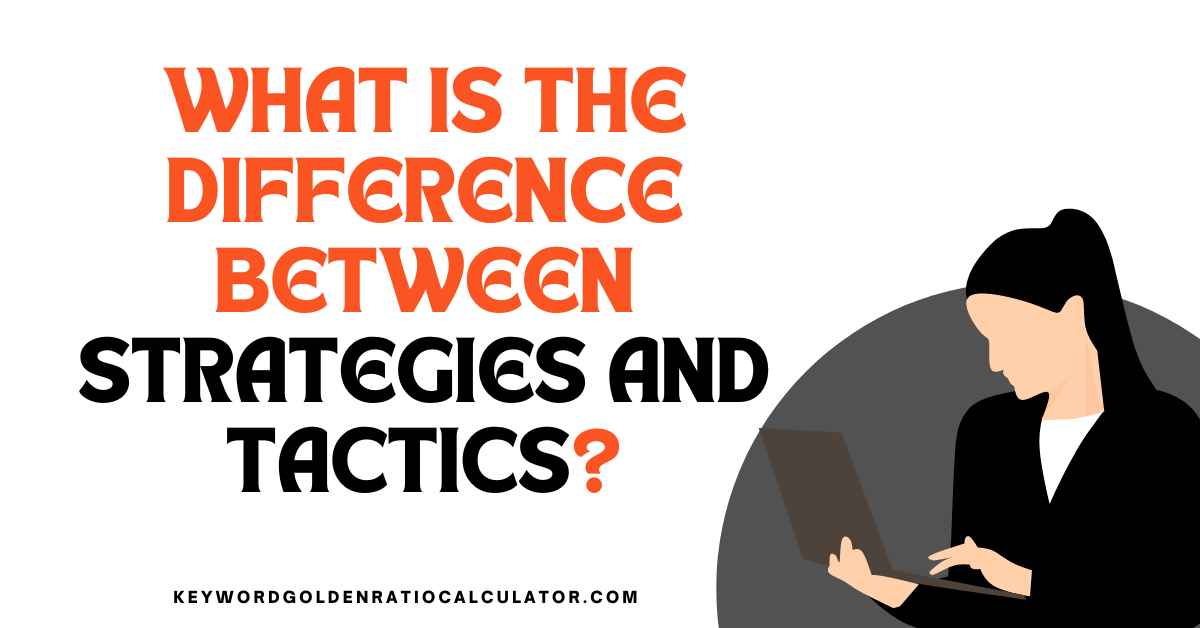In the dynamic and complex world of business, having a solid understanding of strategies and tactics is not just important—it’s critical.
“What is the Difference Between Strategies and Tactics?” you may ask. This is a key question often posed by business leaders, entrepreneurs, and those venturing into the expanse of strategic planning.
In this post, we will delve deep into the differences between these two concepts and highlight how they collectively set the stage for achieving business goals.
The Definition of Strategies
In the realm of business, a strategy refers to a broad master plan meticulously designed to realize a set of high-level, long-term goals. It’s your map that provides the direction and guides all efforts.

The Core Characteristics of Strategies
- They are broad in nature
- They entail long-term planning
- They focus on achieving high-level goals
- They shape the direction of all activities
The Definition of Tactics
The ‘tactics’, on the other hand, refer to the specific actions taken to execute the strategy’s broader master plan.
These are precise, measurable, and short-term in nature, serving as the stepping stones that lead towards achieving the strategic goals.

The Core Characteristics of Tactics
- They are specific and precise
- They entail short-term planning
- They focus on achieving specific, short-term goals
- They serve as the stepping stones towards achieving broader strategic goals
Real-World Examples of Strategies and Tactics in Action
Let’s bring these concepts to life with real-world examples.
Imagine a business that wants to increase its market share (their high-level goal).
Their strategy might be to develop innovative products to stand out in the market.
On the tactical level, they might deploy actions like conducting research about market needs, developing novel prototypes, setting up efficient production lines, and launching effective marketing campaigns.
The Significance of the Difference between Strategies and Tactics
Understanding the difference between strategies and tactics is essential to building and executing successful plans.
It helps in maintaining the distinction between the ‘what’ (strategies) and the ‘how’ (tactics) and allows for precise navigation towards the planned end goals.
Masters of Strategies and Tactics: A Look at Iconic Figures
History is rich with iconic figures who brilliantly balanced between strategies and tactics.
Think of Sun Tzu, the Chinese military strategist who authored ‘The Art of War’.
His teachings echo the essence where strategy provides a vision and tactics bring that vision to fruition.
Conclusion
Unraveling the question, ‘What is the Difference Between Strategies and Tactics?’ is like cracking the code to efficient planning and execution.
Strategies give the broad strokes—the long-term, high-level goals, and general direction.
Conversely, tactics are the short-term, precise steps taken to realize those broader goals.
Both are vital, interlinked, and command their unique significance on the chessboard of leadership.
Whether you’re a seasoned business leader or a budding entrepreneur, mastering the balancing act between strategies and tactics could be your ticket to drive your pursuits to success.
Remember, strategies are your roadmap, and tactics are your vehicle—both imperative to reach your destination!
FAQs – What is the Difference Between Strategies and Tactics?
What is the primary distinction between strategies and tactics?
In easy terms, a strategy is an overall plan aimed at achieving specific long-term outcomes, while tactics are the actions or steps implemented to accomplish the strategy. Strategy gives you the big picture, and tactics fill in the details of that picture.
Can you provide an example that helps illustrate the difference between strategies and tactics?
Sure. Let’s consider a business perspective. Suppose a company’s strategy is to grow its market share by 20% in the next five years. A tactic to achieve this might be to introduce new products each year to attract more customers.
Can a strategy exist without tactics? If not, why?
No, a strategy cannot exist without tactics. While a strategy sets the long-term goals, tactics are the actions needed to achieve these goals. Without tactics, a strategy is simply a plan with no actionable steps.
How often should tactics be evaluated in relation to the overarching strategy?
Tactics should be regularly evaluated to ensure they align with the strategy and are effectively moving you towards your goal. The frequency of evaluation can vary but it’s common to assess tactics on a quarterly basis.
Are tactics more detailed than strategies?
Yes, tactics are more detailed than strategies. Tactics are the specific actions or steps taken, with each tactic acting as a piece of the overall strategy puzzle.
Can tactics change, while the strategy remains the same?
Yes, tactics can change while the strategy remains the same. This occurs when a specific tactic isn’t delivering the anticipated results and needs to be adjusted to better achieve the strategic goal.
Should strategies and tactics always be aligned with each other?
Yes, successful implementation of strategies and tactics requires that they are aligned. Misalignment can lead to ineffective actions and failure to accomplish the long-term goals.
Should the development of strategy or tactics come first?
Strategy should always come before tactics. The strategy provides the framework and long-term goals, which then guides the development of the tactics to achieve those goals.
Are strategies always long-term and tactics short-term?
Generally, strategies are long-term plans, while tactics are short-term actions. However, the time frames can vary depending on the scope of the goals or specific circumstances of a project.
Can a single strategy have multiple tactical approaches?
Yes, a single strategy can, and often does, involve multiple tactical approaches. Different tactics can be used to handle different aspects of the strategy or to cater to different target demographics or areas of focus.

